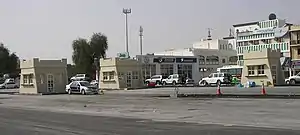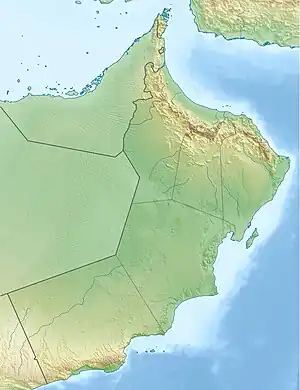Al-Buraimi
Al-Buraimi (Arabic: ٱلْبُرَيْمِي, romanized: Al-Buraymī) is an oasis city and a wilayah (province) in northern Oman, on the border between Oman and the United Arab Emirates. It is the capital of the Al Buraimi Governorate. It is bordered by the wilayas Mahdha and Dhank. It is also bordered by the city of Al Ain in the United Arab Emirates. It is approximately 343 km away from the capital, Muscat, and has taken the motto of the Al Khandaq Fort.
Al-Buraimi
ٱلْبُرَيْمِي | |
|---|---|
 Border between Al-Buraimi (Oman) and Al Ain (the UAE) | |
 Al-Buraimi Location in Oman  Al-Buraimi Al-Buraimi (Persian Gulf) | |
| Coordinates: 24°15′33″N 55°47′2″E | |
| Country | |
| Governorate | Al Buraimi |
| Elevation | 292 m (958 ft) |
| Population (2003)[1] | 67,963 |
| Time zone | UTC+4 |
It is the center of Al Buraimi Governorate and one of its largest provinces in terms of population. It includes several important historical landmarks, such as forts and heritage houses. One of the prominent ones is the "Bayt Bahr" (House of the Sea). Among its castles are Al Fayd-Hafit Castle and Wadi Al Jizi Castle.
Within the province, there are some villages, including around 49 falajs,[2] in addition to extensive sandy deserts. Al Buraimi Governorate serves as a major commercial market, where goods and commodities from neighboring governorates are received. A large market is held there to showcase various necessities.
History
The Al Buraimi Governorate stands out as a unique and expansive Omani market, encompassing a multitude of historical states. In ancient times, around 600 CE, the city of Al Buraimi was an integral part of the Sultanate. Subsequently, Omani Azd tribes took control of the region. The Al Buraimi oasis was eventually abandoned around 700 CE. Throughout history, this area was known as "Tawam" and "Al Jaw," featuring a large oasis consisting of nine villages: Sa'ara, Hamasah, Haili, Al Jaimi, Al Mawijai, Al Mu'tarid, Al Jahili, Al Ain, and Al Qutayrah. The Al Buraimi Governorate serves as a welcoming hub for visitors from various regions, renowned for its hospitable people. The original inhabitants are the Al Nuaimi tribal group, particularly the Al Naimi tribe. Notably, the rebuilding of Al Buraimi saw rulers such as Sultan bin Mohammed Al Hamoud Al Qurtasi Al Nuaimi and later, Sheikh Saqr bin Sultan bin Mohammed Al Hamoud Al Qurtasi Al Nuaimi.[3]
In the pre-Al Saud era, Al Buraimi was governed by the Al Zar'a family. The Al Surur family held authority over Hamasah, the Bani Jaber tribe over Sa'ara, and the Al Azaznah tribe over Al Hailah village. Over time, the region came under the influence of the Al Saud family. Following the passing of Prince Turki bin Ahmed Al Sudairi, a power struggle ensued for control of Al Buraimi between Sheikh Zayed I and Ali bin Hamoud. Sheikh Ali bin Hamoud Al Nuaimi assumed guardianship of the children of Sheikh Al Filani Al Qassar, the ruler of Dhank, and cleverly seized control. His son, Mohammed bin Ali, succeeded him in leadership and sought to make Al Buraimi the capital. During this era, Al Buraimi was under the rule of Hamad bin Abdullah Al Jirahi, known as "Ghubar."
Tensions arose between Ghubar and Sheikh Zayed bin Khalifa Al Nahyan, the ruler of Abu Dhabi. These conflicts nearly resulted in Ghubar's dominance over Al Buraimi. However, intervention by Mohammed bin Ali and his allies paved the way for a peace agreement. Tragically, the Al Azaznah tribe betrayed Mohammed bin Ali, leading to his assassination and their appointment of him as ruler of Al Buraimi. Mohammed bin Ali had strong ties with the Bani Jaber tribe in Sa'ara, eventually assuming leadership around 1290 AH. The Al Hamoud family's rule persisted until 1950, with the final ruler being Sheikh Saqr bin Sultan bin Mohammed Al Hamoud.
Forts
Al-Khandaq Fort:[4]
The Al Khandaq Fort in the Al Buraimi Governorate is considered one of the important landmarks in the province. It was named "Al Khandaq" (The Trench) because it is surrounded by a trench for defensive purposes. This strategic approach was used in the past to protect cities, castles, and forts in Oman since periods before the arrival of Islam. The construction of the fort dates back to the first half of the 19th century AD, which corresponds to the second half of the 13th century AH (Hijri calendar).
The fort is square in shape and consists of approximately ten rooms spread across its area, along with its towers. The fort includes four towers situated at its four corners, and its total area is about 3,070 square meters.
Al-Hilah Fort:[5]
The Hailah Fort is located in the Haraat Al Souq area of the Al Buraimi Governorate. It was built by Sheikh Mohammed bin Ali bin Hamoud Al Nuaimi on an area of approximately 4200 square meters, where the components of the fort are distributed. It is possible that this fort was constructed to replace Al Khandaq Fort and meet the needs of local administration. The fort is surrounded by a wall, with the main facade extending for a length of 79 meters. The northern facade stretches for 53 meters, and the outer wall's height ranges from four to six meters.
The Hailah Fort stands out for its gypsum decorations and designs, setting it apart from others. It is located in the heart of the Al Buraimi oasis. Throughout history, it has been a center of conflict due to its location on the overland route between Sohar and the Persian Gulf, giving it a captivating historical significance.
The fort also includes three fortified tower-like structures that are 10 meters in height. Internally, the fort is divided into two courtyards, northern and southern, each with its associated facilities. The upper residential area features two decorated rooms in various sections adorned with lunar motifs, window grills, and bands beneath the roof. This upper area also has a southern-facing upper band. Throughout the fort, doors and windows are adorned with distinctive carvings on wood, along with some ornate iron windows.
The fort is constructed from stone, gypsum, and clay. The Ministry of Heritage and Culture undertook a restoration project that lasted for 35 months.
Tourism[6]
Al Buraimi Souq
Al Buraimi Souq is one of the most famous tourist destinations in Al Buraimi. It's considered the largest open Arab market. The market stands out for its old architectural charm, with origins dating back to the late 1990s, aimed at reviving traditional Omani handicrafts.
Within the market, you can find a wide range of food products, including vegetables, fruits, various agricultural crops, as well as smoked and dried fish, among others. You can stroll through the market for shopping and purchasing souvenir gifts, including traditional handicrafts such as textiles, silver jewelry, ceramics, and more.
Historical Hafeet Mountain
The historical site of Hafeet Mountain stands as one of the prominent tourist attractions in Al Buraimi, Oman. It holds significant popularity in the region, as it reflects the convergence of two civilizations dating back over 3000 years – the "Bat" and "Umm Al Nar" civilizations.
You can engage in guided tours and enjoy observing the tombs and beehive structures, as well as pottery artifacts associated with the Jamdat Nasr civilization in Iraq. This site holds crucial historical importance and appeals especially to history enthusiasts, offering an exciting glimpse into the past.
Al Buraimi Public Park
One of the essential recreational spots to visit in Al Buraimi city is the Al Buraimi Public Park. This location ranks among the notable tourist destinations in Al Buraimi, Oman, suitable for families and children. It stands as one of the most significant and expansive parks within the governorate.
The park offers its visitors relaxation within vast green spaces, leisurely strolls and walks, long-distance jogging, and playful activities with your children. Additionally, it provides the opportunity to relish dining or outdoor barbecue gatherings.
The Buraimi Crisis
The Buraimi Dispute, also known as the Buraimi Oasis Dispute, was a border conflict involving Saudi Arabia, Oman, and the United Arab Emirates concerning the Al Buraimi Governorate situated within the Sultanate of Oman.
References
- "2003 General Census of Population Housing and Establishments of Oman" (PDF). Archived from the original (PDF) on 2007-11-24. Retrieved 2011-11-16.
- "ولاية البريمي". Oman Info. 17 August 2023. Retrieved 17 August 2023.
- Hajer (11 May 2023). "ملف شامل عن ولاية البريمي أشهر ولايات سلطنة عمان". Almrsal. Retrieved 17 August 2023.
- "حصن الخندق". Oman Info. 17 August 2023. Retrieved 17 August 2023.
- "حصن الحلة". Oman Info. 17 August 2023. Retrieved 17 August 2023.
- Omar, Retaj (2022-02-12). "السياحة في البريمي عمان وأفضل 10 اماكن سياحية تستحق الزيارة". عالم السفر (in Arabic). Retrieved 2023-08-17.